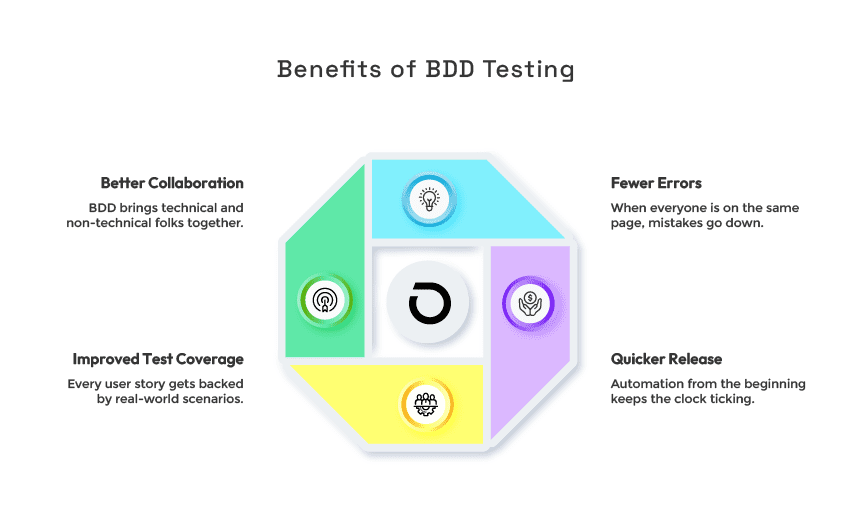In a world where software has to be resilient, seamless, and smart, the pressure on IT managers and testers is mounting by the day. The gap between business goals and technical execution feels like a chasm— until Behavior-Driven Development (BDD) comes along.
BDD speaks in the language of collaboration, where testers, developers, and business users write stories together— stories that make better software.
And with Opkey, these stories come to reality effortlessly. Our no-code, AI-powered platform turns BDD into a powerful force for test automation that is fast, flexible, and intuitive.
Join us as we explore how mastering BDD with Opkey can help you achieve quality, align your teams, and release with confidence every single time.
What is BDD testing?
At its core, BDD is a collaborative approach to software development that focuses on communication between developers, testers, product managers, and business stakeholders. Instead of diving straight into code or test scripts, BDD starts with real-world user behavior and turns those behaviors into formalized, automated tests.
Sounds simple, right? That’s the point.
With BDD, you define how an application should behave using natural language, making it easier for both technical and non-technical team members to stay aligned.
Core Components of BDD
Before diving into automation tools, it’s important to understand the core building blocks of BDD (Behavior-Driven Development). Think of these as the foundation that helps teams stay aligned and deliver better quality software faster.
Here’s a breakdown of the key components:
1. User Stories
These are short, simple descriptions of a feature from the perspective of the end user. They capture what the user wants and why.
Example:
As a returning customer, I want to log in quickly so I can reorder my last purchase.
User stories drive the creation of BDD scenarios and help focus testing on real business needs.
2. Scenarios
Each user story is broken down into concrete scenarios that describe how the system should behave in specific situations.
Scenarios are written in a structured, natural language format using Gherkin syntax.
Gherkin syntax
Given the user is on the login page,
When they enter valid credentials
Then they should be redirected to the dashboard
Tools like Opkey make it easy to write and manage these scenarios— even if you don’t have a technical background.
3. Step Definitions
Behind every Gherkin step, there’s an action. Step definitions connect those written steps to the underlying test logic (or test automation flows in Opkey’s no-code interface).
With Opkey, you can map these steps to reusable test components— no scripting required.
4. Test Runner
This is the engine that actually executes test cases written in BDD format. Whether you’re using BDD tools like Cucumber or a modern platform like Opkey, the test runner validates whether the system behaves as described in your scenarios.
5. Documentation
Because Gherkin scenarios and test scripts are written in plain English, they serve as up-to-date documentation for how the system works. This eliminates the need for separate testing documentation and ensures your business users are always in the loop.
Implementing BDD in Your Workflow
Wondering how to bring BDD into your QA or development process?
Here’s a quick roadmap:
- Start with Collaboration: Get business analysts, testers, and developers in the same room to define behaviors.
- Adopt a Tool That Supports Gherkin: Whether that’s traditional BDD tools or a no-code solution like Opkey, make sure it fits your team’s skill set.
- Automate Early: Turn Gherkin scenarios into automated test cases and use test automation frameworks as early in the cycle as possible.
- Integrate with CI/CD: Make BDD part of your DevOps pipeline for continuous validation.
With Opkey, implementing BDD is a breeze— teams can generate BDD test cases from users, map them to business processes, and automate with minimal effort.
Benefits of BDD Testing

Why is everyone talking about BDD? Because it works. Here’s what teams love about it:
- Better Collaboration: BDD brings technical and non-technical folks together.
- Improved Test Coverage: Every user story gets backed by real-world scenarios.
- Fewer Errors: When everyone is on the same page, mistakes go down.
- Quicker Release: Automation from the beginning keeps the clock ticking.
How BDD Differs from TDD
While both BDD (Behavior-Driven Development) and TDD (Test-Driven Development) aim to improve software quality through testing, they differ in focus, participants, and approach. Here’s a quick comparison:

With Opkey’s no-code BDD capabilities, you get the best of both worlds— robust automation and full team alignment— without writing a single line of code.
Future of Behavior Driven Testing
BDD testing has come a long way from being a developer-driven concept to a collaborative cornerstone of agile teams. As testing evolves, here are some key trends shaping the future of BDD:
1. No-Code & Low-Code BDD Adoption
As business and QA teams seek more autonomy, platforms like Opkey are making BDD testing accessible through no-code interfaces— enabling anyone to write, run, and automate scenarios with Gherkin scenarios without technical expertise.
2. AI-Powered Scenario Generation
Expect AI to play a larger role in BDD testing— automatically generating test scenarios from user stories, usage analytics, or past test runs to enhance test coverage and reduce manual effort.
3. BDD for Complex Enterprise Systems
Enterprises are applying BDD to large-scale ERP platforms like SAP, Oracle, and Workday. Tools like Opkey make this easier with pre-built accelerators and seamless integration into enterprise workflows.
4. Shift-Left + Shift-Right Testing
BDD framework will support Shift-Left (early testing) and Shift-Right (post-deployment validation) strategies. That means behavior-driven tests are helping teams catch issues sooner and validate real-world behavior in production—creating a continuous feedback loop from planning to monitoring.
5. Collaboration in DevOps
BDD fits into DevOps pipelines. As DevOps matures, BDD testing will play a bigger role in breaking down silos between product, QA, and engineering teams.
BDD isn’t just a buzzword— it’s a better way to build software that works.
By aligning teams around real user behavior, BDD brings collaboration, clarity, and confidence from day one. It turns testing into a bridge between business and IT.
And with Opkey’s intuitive user interface, BDD testing is easier than ever. You don’t need a team of automation experts to start, create Gherkin-based test scenarios in minutes, automate BDD scenarios with ease, and keep everyone— from developers to business users— on the same page.
Smarter testing starts here.
Frequently Asked Questions
Behavior- Driven Development (BDD) is a software development process and popular BDD testing frameworks that encourage collaboration between developers, testers, and business stakeholders. The focus is on defining the system behavior in a clear and understandable way, often using natural language. BDD helps ensure that all team members have a shared understanding of what the software should do before development begins.
Cucumber, on the other hand, is a tool that supports the BDD framework. It allows teams to write executable specifications using a domain specific language called Gherkin, which describes system behavior in a format that’s easy to read and understand (e.g., Given-When-Then format).
The three core principles of Behavior Driven Development (BDD) are:
1. Focus on system behavior—BDD emphasizes specifying the expected behavior of the system, ensuring that development aligns with real-world usage.
2. Collaboration in the behavior-driven development process—BDD fosters collaboration among developers, testers, and business stakeholders to create a shared understanding of requirements throughout the software development process.
3. Living Documentation—BDD promotes writing executable specifications in natural language, making the learning curve an integral part of the development process and keeping documentation in sync with the evolving software development.
Writing test scenarios in BDD ensures that tests are aligned with business behavior by defining the initial context, expected actions, and outcomes in a readable format, thus providing better test coverage. This improves collaboration between technical and non-technical stakeholders.
BDD (Behavior-Driven Development) differs from traditional testing because they implement tests by focusing on the expected outcome of software behavior from the user’s perspective, rather than just testing individual units of code.
In BDD, software tests are written using human readable language that describes the initial context, the specific action, and the expected outcome — often in the format of Given-When-Then.
In contrast, traditional unit tests focus more on internal logic and might test a single method in isolation without the broader context or clear business scenario. They often use code-specific assertions without offering concrete examples of the system’s desired behavior.
In summary, BDD frameworks bridge the gap between technical and non-technical stakeholders by providing easy writing scenarios and turning software tests readable format that verifies the system behaves as intended in real-world scenarios.
BDD builds on the principles of Acceptance Test Driven Development by using natural language to define acceptance criteria. While ATDD allows users to write test before development using domain specific language, BDD frameworks enhance collaboration by making those tests readable and accessible across teams, aligning technical efforts with business goals.
When adopting behavior driven testing and the BDD process, teams should be aware of the learning curve, especially in writing clear, consistent scenarios based on acceptance criteria. Proper training and collaboration across stakeholders are key to successfully embedding BDD principles into the development workflow.




